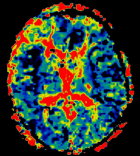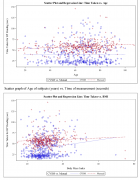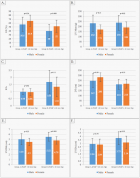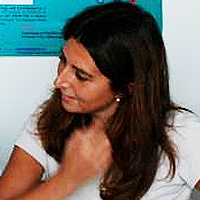Abstract
Review Article
Cortical spreading depolarizations in the context of subarachnoid hemorrhage and the role of ketamine
Leandro Custódio do Amaral*
Published: 23 March, 2021 | Volume 5 - Issue 1 | Pages: 016-021
Delayed cerebral ischemia (DCI) is one of the main complications of spontaneous subarachnoid haemorrhage and one of its causes is the cortical spreading depolarizations (CSDs). Cortical spreading depolarizations are waves of neuronal and glial depolarizations in which there is loss of neuronal ionic homeostasis with potassium efflux and sodium and calcium influx. In damaged brain areas and brain areas at risk, such as those adjacent to subarachnoid haemorrhage (SAH), CSDs induce microvascular vasoconstriction and, therefore, hypoperfusion and spread of ischemia. Several studies have been devoted to minimize secondary injuries that occur hours to days after an acute insult. Ketamine, a drug until recently contraindicated in the neurosurgical population for potentially causing intracranial hypertension, has re-emerged as a potential neuroprotective agent due to its pharmacodynamic effects at the cellular level. These effects include anti-inflammatory mechanisms, and those of microthrombosis and cell apoptosis controls, and of modulation of brain excitotoxicity and CSDs. A literature review was performed at PubMed covering the period from 2002 to 2019. Retrospective studies confirmed the effects of ketamine on the control of CSDs and, consequently, of DCI in patients with SAH, but did not show improvement in clinical outcome. The influence of ketamine on the occurrence/development of DCI needs to be further confirmed in prospective randomized studies
Read Full Article HTML DOI: 10.29328/journal.jnnd.1001045 Cite this Article Read Full Article PDF
Keywords:
ACA: Anterior Cerebral Artery; ADC: Apparent Diffusion Coefficient; ASAH: Aneurysmal Subarachnoid Haemorrhage; CBF: Cerebral Blood Flow; CSDs: Cortical Spreading Depolarizations; DCI: Delayed Cerebral Ischemia; ICP: Intracranial Pressure; MCA: Middle Cerebral Artery; MR: Magnetic Resonance; NMDA: N-Methyl D-Aspartate; rCBV: relative Cerebral Blood Volume; SAH: Subarachnoid Haemorrhage
References
- Von der Brelie C, Seifert M, Rot S, Tittel A, Sanft C, et al. Sedation of Patients with Acute Aneurysmal Subarachnoid Hemorrhage with Ketamine Is Safe and Might Influence the Occurrence of Cerebral Infarctions Associated with Delayed Cerebral Ischemia. World Neurosurg. 2017; 97: 374-382. PubMed: https://pubmed.ncbi.nlm.nih.gov/27742511/
- Hertle DN, Dreier JP, Woitzik J, Hartings JA, Bullock R, et al. Effect of analgesics and sedatives on the occurrence of spreading depolarizations accompanying acute brain injury. Brain. 2012; 135: 2390-2398. PubMed: https://pubmed.ncbi.nlm.nih.gov/22719001/
- Sánchez-Porras R, Zheng Z, Sakowitz OW. Pharmacological modulation of spreading depolarizations. Acta Neurochir Suppl. 2015; 120: 153-157. PubMed: https://pubmed.ncbi.nlm.nih.gov/25366616/
- Welling L, Welling MS, Teixeira MJ, Figueiredo EG. Cortical spread depolarization and ketamine: a revival of an old drug or a new era of neuroprotective drugs? World Neurosurg. 2015; 83: 396-397. PubMed: https://pubmed.ncbi.nlm.nih.gov/25644895/
- Bell JD. In Vogue: Ketamine for Neuroprotection in Acute Neurologic Injury. Anesth Analg. 2017; 124: 1237-1243. PubMed: https://pubmed.ncbi.nlm.nih.gov/28079589/
- Weidauer S, Vatter H, Beck J, Raabe A, Lanfermann H, Seifert V, et al. Focal laminar cortical infarcts following aneurysmal subarachnoid haemorrhage. Neuroradiology. 2008; 50: 1-8. PubMed: https://pubmed.ncbi.nlm.nih.gov/17922121/
- Woitzik J, Dreier JP, Hecht N, Fiss I, Sandow N, et al. Delayed cerebral ischemia and spreading depolarization in absence of angiographic vasospasm after subarachnoid hemorrhage. J Cereb Blood Flow Metab. 2012; 32: 203-212. PubMed: https://pubmed.ncbi.nlm.nih.gov/22146193/
- Santos E, Olivares-Rivera A, Major S, Sánchez-Porras R, Uhlmann L, et al. Lasting s-ketamine block of spreading depolarizations in subarachnoid hemorrhage: a retrospective cohort study. Crit Care. 2019; 23: 427. PubMed: https://pubmed.ncbi.nlm.nih.gov/31888772/
- Eriksen N, Rostrup E, Fabricius M, Scheel M, Major S, et al. Early focal brain injury after subarachnoid hemorrhage correlates with spreading depolarizations. Neurology. 2019; 92: e326-e341. PubMed: https://pubmed.ncbi.nlm.nih.gov/30593517/
- Wartenberg KE, Sheth SJ, Michael Schmidt J, Frontera JA, Rincon F, et al. Acute ischemic injury on diffusion-weighted magnetic resonance imaging after poor grade subarachnoid hemorrhage. Neurocrit Care. 2011; 14: 407-415. PubMed: https://pubmed.ncbi.nlm.nih.gov/21174171/
- Dreier JP, Sakowitz OW, Harder A, Zimmer C, Dirnagl U, et al. Focal laminar cortical MR signal abnormalities after subarachnoid hemorrhage. Ann Neurol. 2002; 52: 825-829. PubMed: https://pubmed.ncbi.nlm.nih.gov/12447937/
- Umesh Rudrapatna S, Hamming AM, Wermer MJ, van der Toorn A, Dijkhuizen RM. Measurement of distinctive features of cortical spreading depolarizations with different MRI contrasts. NMR Biomed. 2015; 28: 591-600. PubMed: https://pubmed.ncbi.nlm.nih.gov/25820404/
- de Crespigny A, Röther J, van Bruggen N, Beaulieu C, Moseley ME. Magnetic resonance imaging assessment of cerebral hemodynamics during spreading depression in rats. J Cereb Blood Flow Metab. 1998; 18: 1008-1017. PubMed: https://pubmed.ncbi.nlm.nih.gov/9740104/
- Sakowitz OW, Kiening KL, Krajewski KL, Sarrafzadeh AS, Fabricius M, et al. Preliminary evidence that ketamine inhibits spreading depolarizations in acute human brain injury. Stroke. 2009; 40: e519-522. PubMed: https://pubmed.ncbi.nlm.nih.gov/19520992/
- Dreier JP, Major S, Manning A, Woitzik J, Drenckhahn C, et al. Cortical spreading ischaemia is a novel process involved in ischaemic damage in patients with aneurysmal subarachnoid haemorrhage. Brain. 2009; 132: 1866-1881. PubMed: https://pubmed.ncbi.nlm.nih.gov/19420089/
Figures:

Figure 1

Figure 2
Similar Articles
Recently Viewed
-
The Accuracy of pHH3 in Meningioma Grading: A Single Institution StudyMansouri Nada1, Yaiche Rahma*, Takout Khouloud, Gargouri Faten, Tlili Karima, Rachdi Mohamed Amine, Ammar Hichem, Yedeas Dahmani, Radhouane Khaled, Chkili Ridha, Msakni Issam, Laabidi Besma. The Accuracy of pHH3 in Meningioma Grading: A Single Institution Study. Arch Pathol Clin Res. 2024: doi: 10.29328/journal.apcr.1001041; 8: 006-011
-
Assessment of Perceptions of Nursing Undergraduates towards Mental Health PracticesAlya Algamdii*. Assessment of Perceptions of Nursing Undergraduates towards Mental Health Practices. Clin J Nurs Care Pract. 2025: doi: 10.29328/journal.cjncp.1001059; 9: 007-011
-
Multipurpose Antioxidants based on Food Industry Waste: Production and Properties EvaluationToshkhodjaev*. Multipurpose Antioxidants based on Food Industry Waste: Production and Properties Evaluation. Arch Food Nutr Sci. 2025: doi: 10.29328/journal.afns.1001062; 9: 001-003
-
Relationship between Fertility Diet Score Index Items and Ovulation in Women with Polycystic Ovary Syndrome: A Narrative ReviewHadis Alimoradi,Faezeh Mashhadi,Ava Hemmat,Mohsen Nematy,Maryam Khosravi,Maryam Emadzadeh,Nayere Khadem Ghaebi,Fatemeh Roudi*. Relationship between Fertility Diet Score Index Items and Ovulation in Women with Polycystic Ovary Syndrome: A Narrative Review. Arch Food Nutr Sci. 2024: doi: 10.29328/journal.afns.1001061; 8: 041-048
-
Evaluation of the LumiraDx SARS-CoV-2 antigen assay for large-scale population testing in SenegalMoustapha Mbow*,Ibrahima Diallo,Mamadou Diouf,Marouba Cissé#,Moctar Gningue#,Aminata Mboup,Nafissatou Leye,Gora Lo,Yacine Amet Dia,Abdou Padane,Djibril Wade,Josephine Khady Badiane,Oumar Diop,Aminata Dia,Ambroise Ahouidi,Doudou George Massar Niang,Babacar Mbengue,Maguette Dème Sylla Niang,Papa Alassane Diaw,Tandakha Ndiaye Dieye,Badara Cisé,El Hadj Mamadou Mbaye,Alioune Dieye,Souleymane Mboup. Evaluation of the LumiraDx SARS-CoV-2 antigen assay for large-scale population testing in Senegal. Int J Clin Virol. 2022: doi: 10.29328/journal.ijcv.1001041; 6: 001-006
Most Viewed
-
Feasibility study of magnetic sensing for detecting single-neuron action potentialsDenis Tonini,Kai Wu,Renata Saha,Jian-Ping Wang*. Feasibility study of magnetic sensing for detecting single-neuron action potentials. Ann Biomed Sci Eng. 2022 doi: 10.29328/journal.abse.1001018; 6: 019-029
-
Evaluation of In vitro and Ex vivo Models for Studying the Effectiveness of Vaginal Drug Systems in Controlling Microbe Infections: A Systematic ReviewMohammad Hossein Karami*, Majid Abdouss*, Mandana Karami. Evaluation of In vitro and Ex vivo Models for Studying the Effectiveness of Vaginal Drug Systems in Controlling Microbe Infections: A Systematic Review. Clin J Obstet Gynecol. 2023 doi: 10.29328/journal.cjog.1001151; 6: 201-215
-
Prospective Coronavirus Liver Effects: Available KnowledgeAvishek Mandal*. Prospective Coronavirus Liver Effects: Available Knowledge. Ann Clin Gastroenterol Hepatol. 2023 doi: 10.29328/journal.acgh.1001039; 7: 001-010
-
Causal Link between Human Blood Metabolites and Asthma: An Investigation Using Mendelian RandomizationYong-Qing Zhu, Xiao-Yan Meng, Jing-Hua Yang*. Causal Link between Human Blood Metabolites and Asthma: An Investigation Using Mendelian Randomization. Arch Asthma Allergy Immunol. 2023 doi: 10.29328/journal.aaai.1001032; 7: 012-022
-
An algorithm to safely manage oral food challenge in an office-based setting for children with multiple food allergiesNathalie Cottel,Aïcha Dieme,Véronique Orcel,Yannick Chantran,Mélisande Bourgoin-Heck,Jocelyne Just. An algorithm to safely manage oral food challenge in an office-based setting for children with multiple food allergies. Arch Asthma Allergy Immunol. 2021 doi: 10.29328/journal.aaai.1001027; 5: 030-037

HSPI: We're glad you're here. Please click "create a new Query" if you are a new visitor to our website and need further information from us.
If you are already a member of our network and need to keep track of any developments regarding a question you have already submitted, click "take me to my Query."















































































































































